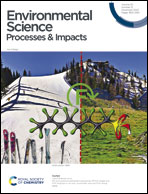Investigating the oxidation mechanism of facet-dependent pyrite: implications for the environment and sulfur evolution†
Abstract
The oxidation of pyrite (FeS2) not only adversely affects the environment, but also plays a critical role in the geochemical evolution of Fe and S elements. However, the oxidation rate of FeS2 is often controlled by its exposed crystal facets. Herein, the oxidation behaviors and mechanisms of naturally existing FeS2(100) and FeS2(210) crystals are investigated. The adsorption models of O2 on FeS2(100) and FeS2(210) facets are established, additionally, their corresponding surface energies, O2 adsorption sites and energies are also obtained using Density Functional Theory (DFT) calculations. These results suggest that the FeS2(210) facet more readily reacts with O2 because it has more unsaturated coordination of Fe atoms compared with the FeS2(100) facet. Moreover, electrochemical results such as EIS, Tafel and CV curves further prove that FeS2(210) possesses a higher oxidation rate than that of FeS2(100). The results of chemical oxidation experiments and XPS analyses show that FeS2(210) can produce more total Fe, SO42− and H+ than FeS2(100). Furthermore, various intermediate S species such as SO32−, S2O32−, S3O62−, S4O62− and S5O62− are also detected. This work can provide a basis for understanding the oxidation mechanism of facet-dependent FeS2 and the geochemical evolution of Fe and S elements.



 Please wait while we load your content...
Please wait while we load your content...